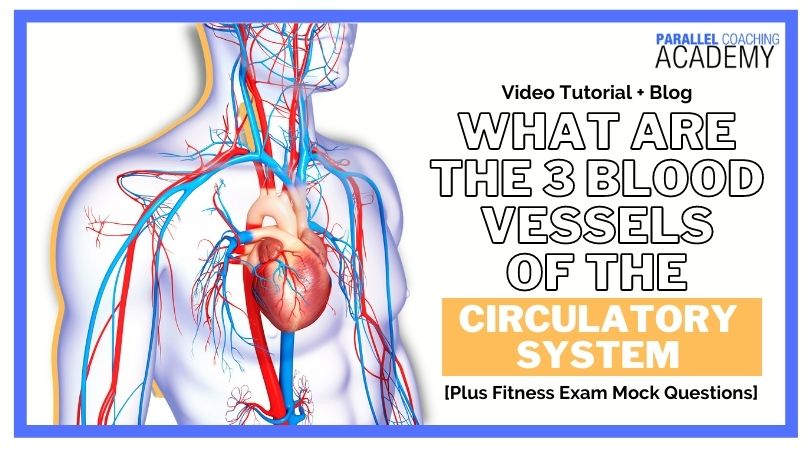The circulatory system is made up of the heart and 3 types of blood vessels.
Today we explore the features and characteristics of each blood vessel to help you prepare for your Level 2 and Level 3 Anatomy Exam
At the bottom of this blog, you’ll also find three mock questions to test your knowledge
Watch the 6 minute video about Blood Vessels:
What Are The 3 Blood Vessels Of The Circulatory System?
There are three different types of blood vessels in the human body:
- Arteries
- Veins
- Capillaries
These each have different functions and characteristics, which we’ll discuss now…
Characteristics of an Artery
Arteries are the thickest of all blood vessels
They have a wide diameter and thick walls
This is important because Arteries carry blood under a high amount of pressure. When the heart forcefully contracts it pushes blood out of the semi-lunar valves and into the arteries. This forceful contraction means that the blood pressure is highest at this point.
Arteries Always carry blood Away from the heart … remember this with A = Away A = Arteries The arteries then carry the blood to the rest of the body, brain, and heart
The arteries usually carry oxygenated blood… with one exception being the Pulmonary Artery
Characteristics of a Vein
Veins are blood vessels with thin walls
They always go towards the heart. Remember this by IN = towards the heart and IN = VeIN
Veins carry de-oxygenated blood from the brain, heart, and body back to the heart…. with the exception of the Pulmonary vein
This means that the blood flowing through the veins is low in pressure. Low pressure means that the blood flow has limited efficiency to get back to the heart. Therefore veins have non-return valves that help prevent the blood from flowing backwards, acting like a one-way system.
Characteristics of a Capillary
A capillary is the smallest of all blood vessels.
It has extremely thin permeable walls, that are just one cell thick.
These thin walls allow nutrients to pass across the membrane and into the lungs, muscles, and other organs.
Capillaries are the delivery mechanism allowing nutrients and waste products to pass in and out of the circulatory system. It is the bridge between our organs /bodily tissues and the blood.
Test your knowledge with more mock questions:
[NOTE: The answers are below the 3rd questions]
Q1: What blood vessel has the largest Diameter?
A. Veins
B. Arteries
C. Capillaries
D. Heart
Q2: What are the characteristics of a vein?
A. Thin walls and non-return valves
B. Thick walls and no valves
C. Thin walls and no vales
D. Thick walls and non-return valves
Q3: Which blood vessel takes de-oxygenated blood back to the heart?
A. Veins
B. Arteries
C. Capillaries
D. Heart
Answers to the mock questions are :
Question 1= B, Question 2 = A, Question 3 = A
If you want more mock questions like this, then you can download more Free Mock Questions: DOWNLOAD NOW
Need More Help with your Level 3 Anatomy Revision?
For Trainee FITPROS Taking Their L3 Anatomy & Physiology Exam.
Learn, Revise & Pass Your Level 3 Anatomy & Physiology Exam In Under 10-hours
(Without Having To Spend Hours Revising Or Feeling Overwhelmed)
If you want to get your revision structured, learn everything you need to know and feel confident on exam day, then click the link below:

Dedicated to More
Hayley “What Are The 3 Blood Vessels Of The Circulatory System?” Bergman
Parallel Coaching
P.S. You can also find us on the following platforms:
Instagram: Follow Now
Facebook: Like Our Page
Twitter: Tweet Us
YouTube: Subscribe Here
More Circulatory System Blogs: HERE

